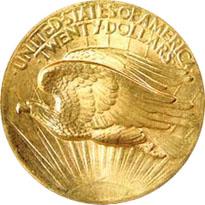The amazing $20 Double Eagle coin
First publicly issued in 1850, the twenty-dollar Double Eagle gold piece was made from gold ore
from the California Gold Rush. In 1907, the coin underwent a radical face-lift at the hands of famed American
sculptor Augustus Saint-Gaudens. The Double Eagle was discontinued in 1933 by executive order, when President
Franklin Roosevelt took the country off the gold standard in an attempt to right the course of the U.S. economy
during the Great Depression. Because People in the U.S. were hoarding gold, the nation's financial system was
undermined and any coins in circulation were strictly forbidden.
With payment or hoarding of gold prohibited,
thousands of citizens turned in their gold to the banks but no one told the U.S. Mint to stop making new gold
coins: The mint produced 445,000 new $20 Double Eagle coins after Roosevelt's order, but never put them
into circulation. In 1937, the U.S. Mint's stockpile of 1933 Double Eagle coins was destroyed (with the exception
of two earmarked for historic preservation, which currently reside at the Smithsonian Institution), but several
coins were stolen and circulated. The Secret Service discovered years later that George McCann, the Mint's chief
cashier, had stolen 10 of the coins, but one by one the Treasury Department and other federal agents recovered
all of them - save one.


How the last 1933 Double Eagle survives to this day is part of the fascination with this rare
coin. In 1944, agents for Egypt's King Farouk -- an eccentric collector of stamps, aspirin bottles, old razor
blades and coins -- applied for an export license for a 1933 Gold Double Eagle. As the result of a Treasury
Department oversight, Egypt was granted the license and a 1933 Double Eagle was housed in the private collection
of King Farouk, one of the greatest coin collectors of all time. It wasn't until a few weeks after the license
was signed that suddenly everyone realized the mistake. The coin was illegal to own, and in fact clearly had been
stolen from the U.S. Mint, but the contemporaneous political climate stymied attempts to retrieve it. In 1944,
the US was in the middle of a world war, and Egypt stood at the crossroads in the middle of the Mediterranean. It
was not the right moment in diplomatic history to go and try to make a claim on a coin, but the coin detectives
waited until 1952, when Farouk was overthrown to get it back.
In 1954, King Farouk's 1933 Double Eagle turned up in Cairo at a state-held auction of the
deposed king's coin collection. The U.S. government recognized that the 1933 Double Eagle was in that collection,
and they officially asked the Egyptian government to pull it from the sale and return it as stolen property of the
United States. Although the coin was withdrawn, it was not returned and authorities lost track of it for more than
45 years. The coin disappeared...
Found, lost and found again
In 1996, British coin dealer Stephen Fentonbrought brought the coin to the Waldorf Astoria Hotel
in New York City, to sell to an American collector. Federal agents, posing as coin collectors, seized the 1933
Double Eagle in a successful sting operation and while it cannot be proven with absolute certainly, it is believed
that this coin is the same 1933 Double Eagle from King Farouk's prized collection. Fenton was put in jail, but he
soon got out and went to court in order to battled the U.S. government over ownership of the coin. Meanwhile the
coin itself was stored in what authorities thought was a secure location: a vault at the World Trade Center.
But the coin was fated to survive yet again. Just weeks before the twin towers were destroyed on
September 11, 2001, the case was settled out of court and the Double Eagle in question - which was minted legally, yet
was illegal to possess - was allowed to be privately owned, and was moved to Fort Knox, Kentucky. It was
subsequently put up for auction. The coin was sold to an anonymous bidder at a Sotheby's auction on July 30, 2002
for the whopping sum of $7,590,020 prompting U.S. Mint director Henrietta Holsman Fore to proclaim the 1933
Double Eagle "the most valuable coin in the world."
| Another expensive coin |
On August 30, 1999, the Sultan of Muscat 1804 Silver Dollar was sold for $4.14 million dollars at a New
York City auction held by Bowers and Merena, because of its condition and its rarity. The coin is thought
to be one of 8 silver dollars presented as proofs to the Sultan of Muscat in 1835. However, the coin was
minted in 1834, but the date on it is incorrect because only an 1804 mold was available
|